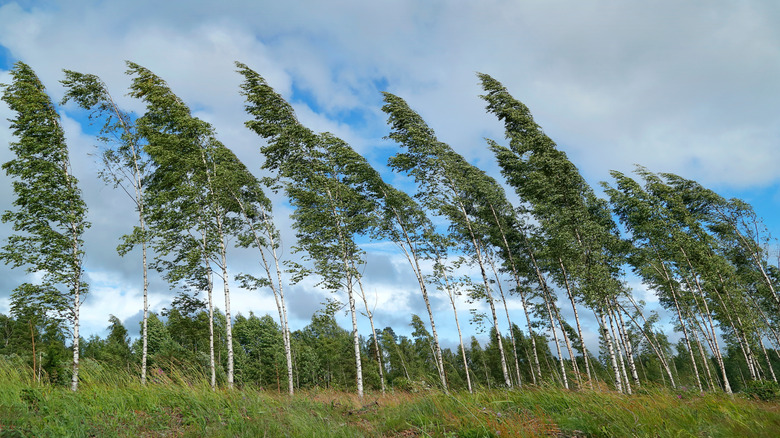Wind Rock: What Is It And Why Is It So Dangerous For Plants?
Strong winds can be a real threat in any garden, and that's why they're so dangerous for plants. Repeated gusts can cause tall, top-heavy, or shallow-rooted plants to wobble at the base, which makes the soil surrounding their roots looser and unstable. This rocking motion, when caused by high winds, is called wind rock, and it can quietly weaken plants long before the damage becomes obvious to gardeners. Wind rock is especially common in exposed gardens, particularly those in coastal areas and places where strong winds can funnel between buildings or over open ground. Gardeners will often need to step in to help keep vulnerable plants stable.
While there are some beautiful trees that can survive in extremely windy environments, newly planted shrubs and young trees or plants are susceptible to wind rock because they're still forming their root systems. Even established plants can be affected when prolonged gales or storms constantly move plants at the base. Wind rock is dangerous because strong winds can repeatedly pull on a plant, and the resulting rocking motion can loosen or damage the roots. This instability stresses the plant. It will have a harder time staying hydrated and more susceptible to disease and pests that can enter through damaged plant tissue or wind-splintered branches. Fortunately, there are methods to reduce wind damage and shield plants from harm.
How to prevent wind rock and reduce the chance of damage
You can prevent destabilization and protect your garden from startling weather conditions with this tactic: using plants as a natural barricade (creating windbreaks), support stakes, mulching, and pruning. Staking young or newly transplanted trees can help stabilize them while they mature, but they need to be removed eventually. The best time to remove stakes from your newly planted trees is once they anchor fully into the ground — typically a year or two after planting.
Because wind rock is driven by exposure, the most effective long-term protection comes from creating shelter, called a windbreak, that diffuses wind. Windbreaks reduce some of the damage by preventing strong gusts from reaching your plants. Hedges are one of the best natural options because they allow air to pass through while reducing wind speed. Dense, wind-tolerant shrubs and layered plantings offer similar benefits. Strategic planting — like cluster planting or staggered rows — can help slow prevailing winds and create calmer pockets in your garden without using fences.
Good maintenance practices make a major difference, too. A layer of mulch or piled dirt can help plants retain moisture under stress. Keeping the soil evenly moist helps roots stay hydrated during windy periods. Pruning excessively tall or top-heavy shrubs might ease the strain on the root base. Trees in windy regions benefit from gradual crown-thinning that allows air to pass through.

